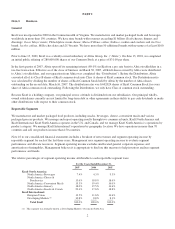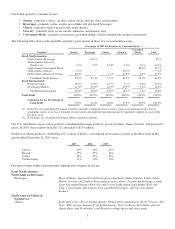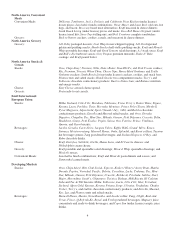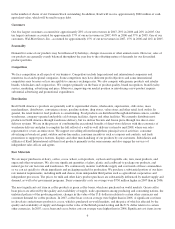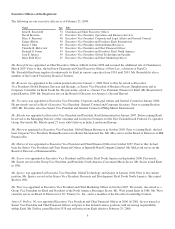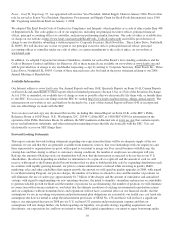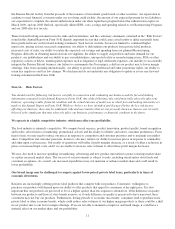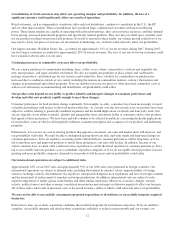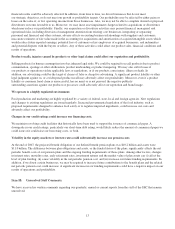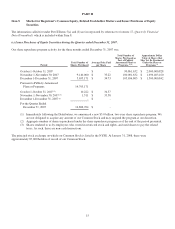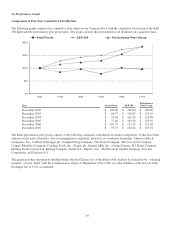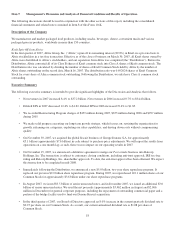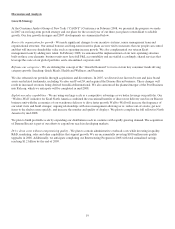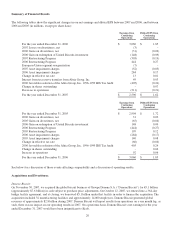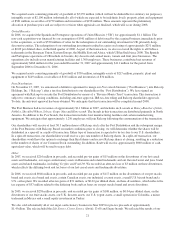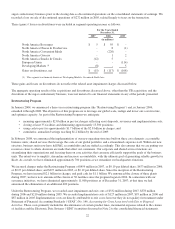Kraft 2007 Annual Report Download - page 27
Download and view the complete annual report
Please find page 27 of the 2007 Kraft annual report below. You can navigate through the pages in the report by either clicking on the pages listed below, or by using the keyword search tool below to find specific information within the annual report.Consolidation of retail customers may affect our operating margins and profitability. In addition, the loss of a
significant customer could significantly affect our results of operations.
Retail customers, such as supermarkets, warehouse clubs and food distributors, continue to consolidate in the U.S., the EU
and our other major markets. These consolidations have produced large, sophisticated customers with increased buying
power. These larger retailers are capable of operating with reduced inventories, they can resist price increases, and they demand
lower pricing, increased promotional programs and specifically tailored products. They also may use shelf space currently used
for our products for their own private label products. If we fail to respond to these trends, our volume growth could slow or we
may need to lower our prices or increase our investments in marketing, any of which could adversely affect our profitability.
Our largest customer, Wal-Mart Stores, Inc., accounted for approximately 15% of our net revenues during 2007. During 2007,
our five largest customers accounted for approximately 28% of our net revenues. The loss of any one of our top customers could
have a material adverse affect on our sales.
Continuing increases in commodity costs may affect our profitability.
We are a major purchaser of commodities including, dairy, coffee, cocoa, wheat, corn products, soybean and vegetable oils,
nuts, meat products, and sugar and other sweeteners. We also use significant quantities of glass, plastic and cardboard to
package our products, and natural gas for our factories and warehouses. Price volatility for commodities we purchase has
increased due to conditions outside of our control, including fluctuations in commodities markets, currency fluctuations and
changes in governmental agricultural programs. If we are unable to increase our prices to offset increased commodity costs or
achieve cost efficiencies in manufacturing and distribution, our profitability could suffer.
Our product sales depend on our ability to predict, identify and interpret changes in consumer preferences and
develop and offer new products rapidly enough to meet those changes.
Consumer preferences for food products change continually. For example, recently, consumers have been increasingly focused
on health and wellness with respect to the food products they buy. As a result, over the last several years our products have been
subject to scrutiny relating to genetically modified organisms and the health implications of obesity and trans-fatty acids. Our
success depends on our ability to predict, identify and interpret the tastes and dietary habits of consumers and to offer products
that appeal to those preferences. We have been and will continue to be affected by publicity concerning the health implications
of our products, some of which could negatively influence consumer perception and acceptance of our products and marketing
programs.
Furthermore, if we do not succeed in offering products that appeal to consumers, our sales and market share will decrease, and
our profitability will suffer. We must be able to distinguish among short-term fads, mid-term trends and long-term changes in
consumer preferences. If we are unable to accurately predict which shifts in consumer preferences will be long-term, or if we
fail to introduce new and improved products to satisfy those preferences, our sales will decline. In addition, because of our
varied consumer base, we must offer a sufficient array of products to satisfy the broad spectrum of consumer preferences. If we
fail to successfully innovate products across a multitude of product categories or if we do not rapidly develop products in faster
growing and more profitable categories, demand for our products will decrease and our profitability could suffer.
Our international operations are subject to additional risks.
Approximately 42% of our 2007 sales and approximately 39% of our 2006 sales were generated in foreign countries. Our
international operations are subject to inherent risks, including fluctuations in currency values, unpredictability of foreign
currency exchange controls, discriminatory fiscal policies, unexpected changes in local regulations and laws in foreign countries
and the uncertainty of enforcement of remedies in foreign jurisdictions. In addition, international sales are subject to risks
related to imposition of tariffs, quotas, trade barriers and other similar restrictions. Moreover, economic changes, terrorist
activity, political unrest and other economic or political uncertainties may interrupt or otherwise negatively affect our business.
All of these risks could result in increased costs or decreased revenues, either of which could adversely affect our profitability.
We may not be able to successfully consummate proposed acquisitions or divestitures or successfully integrate acquired
businesses.
From time to time, we evaluate acquisition candidates that would strategically fit our business objectives. If we are unable to
complete, successfully integrate and develop these acquisition candidates to realize revenue growth and cost savings, our
12


